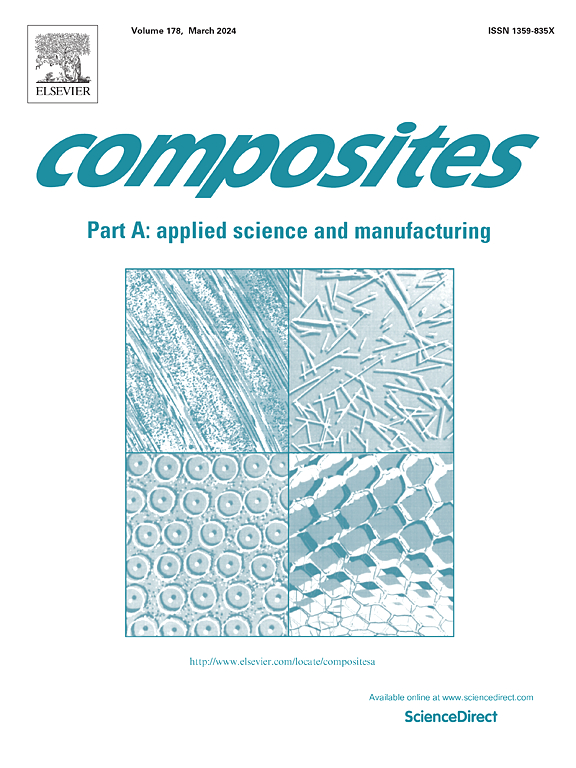Insert-injection moulding and post-thermal treatment of hybrid continuous and discontinuous glass-fibre-reinforced polyamide composite products
IF 8.1
2区 材料科学
Q1 ENGINEERING, MANUFACTURING
Composites Part A: Applied Science and Manufacturing
Pub Date : 2024-10-18
DOI:10.1016/j.compositesa.2024.108534
引用次数: 0
Abstract
Insert-injection moulding enables direct interfacial bonding of hybrid continuous and discontinuous fibre-reinforced thermoplastic products and simultaneously influences dimension stability and mechanical performance. This study investigates the insert-injection moulding of short-glass-fibre-reinforced polyamide 6 (SGF-PA6) bonded with 8 wt% unidirectional continuous-glass-fibre-reinforced polyamide 6 (CGF-PA6), focusing on the dimensional and mechanical properties of the hybrid CGF-SGF-PA6 products, which are essential for engineering applications. Orthogonal experiments revealed that injection melt temperature and pack pressure significantly impact warping deformation and bending properties. The study found strong correlations between dimensional stability and mechanical strength, with interfacial bonding influencing mechanical strength only. Optimised injection moulding reduced warpage to below 0.1 mm, while increasing bending strength and modulus to 400 MPa and 10 GPa, respectively. Post-thermal treatment further enhanced mechanical properties but led to increased warpage. These findings highlight an integrative control strategy for dimensional and mechanical properties of insert-injection moulded hybrid continuous and discontinuous fibre-reinforced thermoplastic products.
混合连续和不连续玻璃纤维增强聚酰胺复合材料产品的嵌入注塑成型和后热处理
嵌入注塑成型可使混合连续和非连续纤维增强热塑性产品直接进行界面粘合,并同时影响尺寸稳定性和机械性能。本研究调查了短玻纤增强聚酰胺 6(SGF-PA6)与 8 wt%单向连续玻纤增强聚酰胺 6(CGF-PA6)粘合的嵌件注塑成型,重点研究了对工程应用至关重要的混合 CGF-SGF-PA6 产品的尺寸和机械性能。正交实验显示,注射熔体温度和包装压力对翘曲变形和弯曲性能有显著影响。研究发现,尺寸稳定性和机械强度之间存在很强的相关性,而界面粘合只影响机械强度。优化后的注塑成型将翘曲变形降至 0.1 毫米以下,同时将弯曲强度和模量分别提高到 400 兆帕和 10 千兆帕。后热处理进一步提高了机械性能,但导致翘曲增加。这些研究结果突显了针对插入注塑混合连续和不连续纤维增强热塑性塑料产品的尺寸和机械性能的综合控制策略。
本文章由计算机程序翻译,如有差异,请以英文原文为准。
求助全文
约1分钟内获得全文
求助全文
来源期刊

Composites Part A: Applied Science and Manufacturing
工程技术-材料科学:复合
CiteScore
15.20
自引率
5.70%
发文量
492
审稿时长
30 days
期刊介绍:
Composites Part A: Applied Science and Manufacturing is a comprehensive journal that publishes original research papers, review articles, case studies, short communications, and letters covering various aspects of composite materials science and technology. This includes fibrous and particulate reinforcements in polymeric, metallic, and ceramic matrices, as well as 'natural' composites like wood and biological materials. The journal addresses topics such as properties, design, and manufacture of reinforcing fibers and particles, novel architectures and concepts, multifunctional composites, advancements in fabrication and processing, manufacturing science, process modeling, experimental mechanics, microstructural characterization, interfaces, prediction and measurement of mechanical, physical, and chemical behavior, and performance in service. Additionally, articles on economic and commercial aspects, design, and case studies are welcomed. All submissions undergo rigorous peer review to ensure they contribute significantly and innovatively, maintaining high standards for content and presentation. The editorial team aims to expedite the review process for prompt publication.
 求助内容:
求助内容: 应助结果提醒方式:
应助结果提醒方式:


